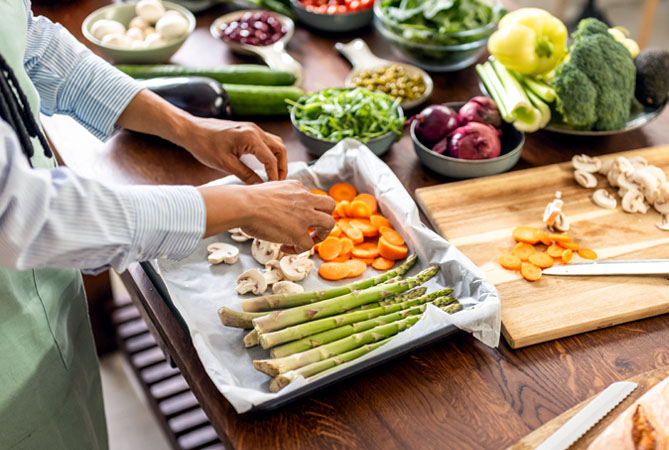Spring into Savings
Tools to Plan Ahead!
Keeping a refrigerator and pantry stocked with healthy foods can make all the difference when you are trying to make good choices when it comes to what you eat. But often we hear, "Eating healthy costs too much money," or "It’s tough for me to find time to grocery shop, and I don’t really know what to buy when I do get there."
Grocery shopping is an important part of supporting a healthy lifestyle, and it doesn't have to be expensive or hard to do. Our Blue Cross & Blue Shield of Mississippi Registered Dietitians have put together some tips to help your grocery shopping trips be shorter and hassle-free! We've also provided some additional resources in the "Tools to Plan Ahead!" section above.
Make a shopping list and stick to it. Start a shopping list by taking inventory of the items you already have on hand. Try to use those items that you already have to plan meals for the following week. Then, add the other products you may need for the week to your list. Or, if it's easier for you, keep a running list on your refrigerator and write down items as they come to mind throughout the week so that your list is ready when it’s time to shop.
Avoid extra shopping trips. How many times have you been to the grocery store to buy just one thing? Did you leave with only that one item? Probably not. Avoiding extra shopping trips can help you avoid impulse buys and spending money on items you don’t really need.
Don’t shop when you are hungry. Eating a healthy snack before you go grocery shopping can help you stick to your list and avoid impulse buys on foods that often look appealing when you are hungry.
Check out the "pre-chopped" section. Many grocery stores chop up and package fresh produce in the store so it makes for quick and easy meal prep or snacking. Keeping fresh chopped fruits and vegetables on hand means that you have one less excuse for not cooking or snacking healthy!
Shop the perimeter. The departments on the perimeter of the supermarket… produce, meat, dairy, eggs, and bread and include most staple items and healthy foods. The inner isles of the supermarket are full of processed foods that tend to be high in fat, sodium, and sugar and low on essential nutrients.
Save with seasonal produce. Buying fruits and vegetables that are "in season" means that the time of year is right for growing in your area. Seasonal produce costs less because it is often grown nearby and the cost of delivering to your grocery store is less. Produce is also more nutritious and flavorful during its peak seasons. See our seasonal produce guides to learn what is best right now!
Fresh is best, but frozen can be too! Frozen veggies often cost less than fresh and are frozen shortly after harvesting. So often they contain as many vitamins and nutrients as fresh produce! Just be sure to check the ingredient list to guarantee that there are no added sauces or flavors. The name of the vegetable should be the only item on the list ( i.e. INGREDIENTS: Spinach).
Look beyond the marketing. Supermarkets are designed to make you spend more, especially on unhealthy foods. Walk past the $1 bins that are filled with candy and avoid the pastries placed near the fresh produce. Flip the food package over and read the nutrition label to determine if it is a healthy product for you, don't just believe the health claims on the front of the package. Check out our 'Decode the Nutrition Label' article to learn more.
To learn more about ways you can eat healthy, visit the "Article Archive" section using the link at the right.




 Women's Health
Women's Health Eat Healthy
Eat Healthy Exercise
Exercise Health & Wellness Articles
Health & Wellness Articles